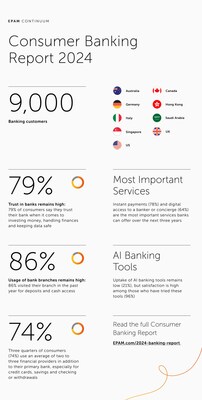EPAM Continuum's 2024 Consumer Banking Report Highlights AI Success with a 96% Satisfaction Rate
- None.
- None.
Insights
The recent Consumer Banking Report by EPAM Continuum indicates a robust customer satisfaction level within the banking sector, which is a positive signal for the industry's stability and potential for customer retention. However, the growing competition from fintech disruptors poses a significant threat to traditional banks, as these new entrants are capitalizing on the demand for personalized and convenient digital experiences. This trend suggests a shift in consumer preferences towards more agile and tech-driven financial services, which could pressure established banks to accelerate their digital transformation strategies.
Moreover, the high trust in banks to manage finances securely is juxtaposed with a considerable portion of younger consumers willing to switch banks for better rates and rewards. This could indicate a looming challenge for banks in terms of deposit retention and customer loyalty. The reported high usage of bank branches, despite digital services availability, reveals a market segment that remains apprehensive about fully transitioning to digital banking, which banks could target with hybrid service models.
The uptake of AI banking tools, as reported, is relatively low, but the satisfaction among users is notably high. This discrepancy highlights a significant opportunity for banks to educate and build trust with their customer base regarding the benefits of AI in financial services. The reluctance to accept AI recommendations, especially among older demographics, underscores the need for a nuanced approach to integrating technology that addresses varying comfort levels and preferences.
Additionally, the fact that consumers maintain relationships with multiple financial providers can be seen as a reflection of the evolving financial ecosystem, where specialized services offered by fintechs complement traditional banking offerings. This trend could lead banks to consider strategic partnerships with fintech companies to expand their service portfolios and meet the diverse needs of their customers.
The report's findings align with broader economic trends, such as high interest rates and market volatility, which have not significantly eroded consumer trust in banks. This resilience in trust is essential for the banking sector's health amidst economic uncertainties. However, the potential for customer migration to fintech alternatives for better rates and rewards could signal a shift in the competitive landscape, with implications for banks' deposit bases and profit margins.
The emphasis on open banking in the U.S., as highlighted by the Forrester report, points to regulatory trends that may reshape the industry. Banks' ability to adapt to regulatory changes and leverage them to offer more transparent and customer-centric services will likely be a critical factor in their competitive positioning in the coming years.
Report underscores increasing consumer expectations for enhanced digital capabilities, with the emergence of fintech disruptors offering more personalized and convenient digital experiences
The 2024 survey of adults across key banking geographies, including
"In the face of rapidly changing market dynamics, marked by high interest rates, inflationary pressures and market volatility, banks have managed to uphold elevated levels of trust and customer satisfaction," said Balazs Fejes, President of EU and APAC Markets at EPAM. "To remain competitive in this evolving climate, banks must embrace automation for improved personalization and engagement across all customer channels, leveraging AI for operational efficiency and forging technology partnerships to drive innovation and cost reduction."
Key emerging themes:
- Trust in banks remains high (
79% ) when it comes to investing money, handling finances and keeping data safe. However,30% (rising to37% for those 18-34) are still considering changing banks in the next 12 months, lured by better rates and rewards elsewhere. - Usage of bank branches remains high, with
86% visiting in the past year, mainly for deposits and cash access. This is despite respondents' awareness that most services are available digitally, revealing a lingering discomfort with moving to fully digital or remote banking. - Instant payments (
78% ) and digital access to a banker or concierge (64% ) are deemed the most important services banks can offer over the next three years, with respondents showing an appetite for more financial advice and money management support from banks. - Uptake of AI banking tools remains low (
21% ), but satisfaction is high among those who have used these tools (96% ). However,57% would not feel comfortable acting on AI financial recommendations, with discomfort being the highest among older demographics. - Three-quarters of consumers (
74% ) use an average of two to three financial providers in addition to their primary bank, especially for credit cards, savings and checking or withdrawals, with25% using third-party money management apps.
Insights from EPAM's 2024 Consumer Banking Report reflect findings from a recent 2024 Forrester banking predictions report. The Forrester report states, "In 2024, we see risks to banks retaining deposits as they strain to maintain profit margins. Likewise, hot yet unproven AI technologies could cause as many new problems as solve old ones. Regulators will have to (re)act. Banks in the US will have to focus on open banking as regulators finally put it on the agenda. Despite the knock-on effects of trepidation in capital markets, intrepid fintechs will create niche products and journeys for niche segments." 1
The fourth annual Consumer Banking Report by EPAM Continuum summarizes emerging trends, attitudes and behaviors, illustrating their potential impact on the future of banking across various demographics and geographical locations.
To read the full 2024 Consumer Banking Report, visit: epam.com/2024-banking-report.
To learn more about EPAM Continuum's integrated business, experience, technology and data consulting practice, visit: www.epam.com/epam-continuum.
Learn how EPAM helps financial services companies keep pace with emerging technologies, rising customer expectations and ever-changing regulations: www.epam.com/industries/financial-services.
Methodology
The data published in this report is based on a survey of 9,000 adults aged 18+ in
ABOUT EPAM SYSTEMS
Since 1993, EPAM Systems, Inc. (NYSE: EPAM) has used its software engineering expertise to become a leading global provider of digital engineering, cloud and AI-enabled transformation services, as well as a leading business and experience consulting partner for global enterprises and ambitious startups. We address our clients' transformation challenges by fusing EPAM Continuum's integrated strategy, experience and technology consulting with our 30+ years of engineering execution to speed our clients' time to market and drive greater value from their innovations and digital investments.
We deliver globally, but engage locally with our expert teams of consultants, architects, designers and engineers, making the future real for our clients, our partners and our people around the world.
We believe the right solutions are the ones that improve people's lives and fuel competitive advantage for our clients across diverse industries. Our thinking comes to life in the experiences, products and platforms we design and bring to market.
Added to the S&P 500 and the Forbes Global 2000 in 2021 and recognized by Glassdoor as a Best Workplace in 2023 and 2024, our multidisciplinary teams serve customers across six continents. We are proud to be among the top 15 companies in Information Technology Services in the Fortune 1000 and to be recognized as a leader in the IDC MarketScapes for Worldwide Experience Build Services, Worldwide Experience Design Services and Worldwide Software Engineering Services as well as a leader in the 2023 Gartner® Magic Quadrant™ for Custom Software Development Services, Worldwide.*
Learn more at www.epam.com and follow us on LinkedIn.
*Gartner does not endorse any vendor, product or service depicted in its research publications, and does not advise technology users to select only those vendors with the highest ratings or other designation. Gartner research publications consist of the opinions of Gartner's research organization and should not be construed as statements of fact. Gartner disclaims all warranties, expressed or implied, with respect to this research, including any warranties of merchantability or fitness for a particular purpose.
Forward-Looking Statements
This press release includes estimates and statements which may constitute forward-looking statements made pursuant to the safe harbor provisions of the Private Securities Litigation Reform Act of 1995, the accuracy of which are necessarily subject to risks, uncertainties, and assumptions as to future events that may not prove to be accurate. Our estimates and forward-looking statements are mainly based on our current expectations and estimates of future events and trends, which affect or may affect our business and operations. These statements may include words such as "may," "will," "should," "believe," "expect," "anticipate," "intend," "plan," "estimate" or similar expressions. Those future events and trends may relate to, among other things, developments relating to the war in
1 Forrester, "Predictions 2024: Banking", Jacob Morgan, Aurelie L'Hostis, Alyson Clarke, Peter Wannemacher with David Hoffman,Laura Koetzle, Sohm Gough, Kerstin Wehmeyer, Aaron Suiter, Jen Barton, October 30, 2023
![]() View original content to download multimedia:https://www.prnewswire.com/news-releases/epam-continuums-2024-consumer-banking-report-highlights-ai-success-with-a-96-satisfaction-rate-302065213.html
View original content to download multimedia:https://www.prnewswire.com/news-releases/epam-continuums-2024-consumer-banking-report-highlights-ai-success-with-a-96-satisfaction-rate-302065213.html
SOURCE EPAM Systems, Inc.









